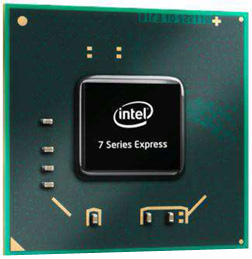Intel 7th Series Chipsets - A Comparative Overview
 Almost two months ago, on April 9, Intel officially announced the release of a new, seventh series chipset. And although information about these chipsets has been discussed before for almost a year, I think it makes sense once again to bring together all their main characteristics and functions in one text. Indeed, it is one thing to simply discuss, and quite another to go to the store after discussion and purchase the selected device or set of components.
Almost two months ago, on April 9, Intel officially announced the release of a new, seventh series chipset. And although information about these chipsets has been discussed before for almost a year, I think it makes sense once again to bring together all their main characteristics and functions in one text. Indeed, it is one thing to simply discuss, and quite another to go to the store after discussion and purchase the selected device or set of components.So, the seventh series chipsets (codename Panther Point) are designed for new generation Ivy Bridge processors, in addition, the previous generation Sandy Bridge processors are also supported. In general, the chipset picture looks like this:
| Intel Q75 Express Chipset | Desktop PCs - Corporate Segment |
| Intel Q77 Express Chipset | |
| Intel B75 Express Chipset | |
| Intel Z77 Express Chipset | Desktop PCs - Consumer Segment |
| Intel Z75 Express Chipset | |
| Intel H77 Express Chipset | |
| Mobile Intel HM75 Express Chipset | Mobile PCs - consumer segment |
| Mobile Intel HM76 Express Chipset | |
| Mobile Intel HM77 Express Chipset | |
| Mobile Intel UM77 Express Chipset | |
| Mobile Intel QM77 Express Chipset | Mobile PCs - corporate segment |
| Mobile Intel QS77 Express Chipset |
- Integrated video on the graphics core of the processor (that is, in fact, motherboards "without video" are now absent as a class, although there is no video as such on them);
- Connect up to 3 independent monitors;
- Integrated network card 10/100 / 1000Base-T;
- Integrated Intel High Definition Audio;
- DDR3 memory (up to 1600 MHz).
Chipsets for home PCs

The logic of building rulers is approximately the same as in the sixth series. In the class of desktop home PCs, there will be a Z-series with great overclocking potential. The flagship of the series, the Z77, as well as the former “massive” charged model Z68, will be able to meet the needs of most demanding home users - well, there are still X79 for maniacs. H77 is a workhorse with a target audience, who needs to go, not checkers.
All chipsets support Intel Rapid Storage Technology. Rumors about the death of the PCI bus in home motherboards turned out to be somewhat exaggerated - PCI slots are still present, but the PCI controller is moved out of the chipset and made by a third-party manufacturer - a sure sign of its early elimination.
| Z77 | Z75 | H77 | |
|---|---|---|---|
| PCI Express 3.0 Slots | 1x16 or 1x8 + 1x8 or 1x8 + 2x4 * | 1x16 or 1x8 + 1x8 or 1x8 + 2x4 | 1x16 or 1x8 + 2x4 |
| PCI Express 2.0 Lines | eight | eight | eight |
| SATA2 Ports (SATA3) | 4 (2) | 4 (2) | 4 (2) |
| USB2 Ports (USB3) | 10 (4) | 10 (4) | 10 (4) |
| Intel Smart Response Technology | Yes | Not | Yes |
| CPU overclocking | Yes | Yes | Not |
Chipsets for business PCs

The line of business chipsets, as usual, focuses on remote monitoring and administration, as well as corporate security. Here and now the flagship technology vPro (about which we have already described in detail ), and Intel Standard Manageability (ISM) and Intel Small Business Advantage (SBA). The B75 chipset, the youngest in the line, is positioned as a solution for small and medium-sized businesses; more expensive counterparts are proposed for use in large corporate networks with developed centralized management of IT infrastructure.
Unlike home chipsets, corporate so far contain a “native” PCI controller, but, I think, this is also not for long.
| Q77 | Q75 | B75 | |
|---|---|---|---|
| PCI Express 2.0 Lines | eight | eight | eight |
| SATA2 Ports (SATA3) | 4 (2) | 5 (1) | 5 (1) |
| USB2 Ports (USB3) | 10 (4) | 10 (4) | 8 (4) |
| Intel Smart Response Technology | Yes | Not | Not |
| Management and Monitoring Technologies | vPro / ISM / SBA | ISM | SBA |
Mobile Chipsets

In the mobile chipset category, the HM77 has the richest functionality, while the UM77, on the contrary, has a chipset with reduced functionality but lower power consumption. In general, it can be said that mobile chipsets in a somewhat reduced form inherit the capabilities and technologies of their desktop counterparts, reflecting, naturally, the mobility nuances.
| HM75 | HM76 | HM77 | UM77 | QM77 | QS77 | |
|---|---|---|---|---|---|---|
| PCI Express 2.0 Lines | eight | eight | eight | four | eight | eight |
| SATA2 Ports (SATA3) | 4 (2) | 4 (2) | 4 (2) | 3 (1) | 4 (2) | 4 (2) |
| USB2 Ports (USB3) | 12 (0) | 8 (4) | 10 (4) | 6 (4) | 10 (4) | 10 (4) |
| Intel Rapid Storage | Not | Not | Yes | Yes | Yes | Yes |
- Intel Anti-theft Technology (protection against "theft" of the laptop);
- Intel Rapid Start Technology (advanced hibernation and acceleration of exit from it);
- Intel Smart Connect Technology (support network activity during "sleep").
Dry residue
So what does Intel have the honor to offer us in the seventh family? Essential "chip", perhaps, only one - PCI Express 3.0. Less significant, but rather pleasant - native, but not hinged USB 3.0. All the rest, practically without any changes, migrated from at least the sixth series. Is it a lot or a little? Say, for the transition from the same Intel 6x - most likely not enough. However, let's not forget that the chipset is just a nice addition to the processor. If the new Ivy Bridge processor family is just as popular as the previous one, then the Intel 7x chipsets will forget about the lack of memory gain, and just 2 high-speed SATA ports.
So, the future of the seventh series of chipsets entirely depends on how much the new ivy bridge from Intel will appeal to users.
')
Source: https://habr.com/ru/post/144545/
All Articles